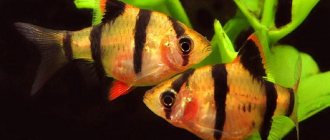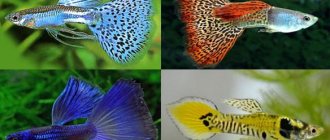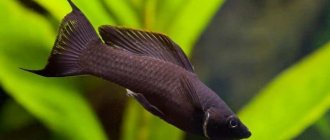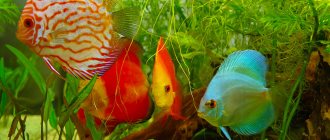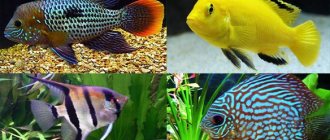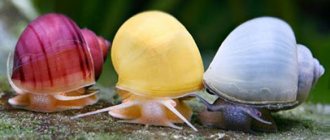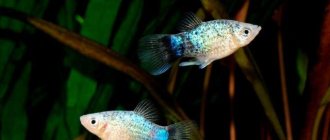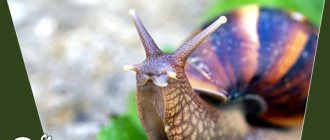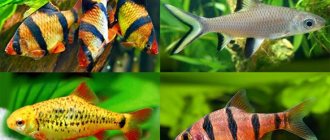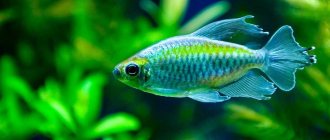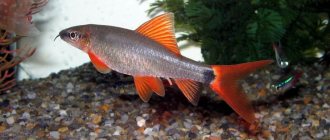Ternetia attracts many aquarists. A large number of breeders note its calm disposition, ease of care and maintenance, as well as its aesthetic appearance.
In order for the fish to feel comfortable and delight the owner with its beauty for a long time, it is necessary to properly care for it. This article will tell you how to keep Ternetia, what to feed and how to breed.
Maintenance and care
Ternetia must be kept in a flock. There should be approximately 9 individuals in it. Otherwise, the fish will show aggression towards other inhabitants of the container. It is also important that the aquarium has a lid on top, as it can jump out of the water.
The tank capacity should be from 60 liters. This will avoid too close contact with neighbors and give the fish enough space to move around comfortably.
The soil you should choose is gravel, small pebbles or sand. You can use driftwood or plants for decoration. In addition to the aquarium, you must purchase an internal filter with a pump. This will help avoid stagnation. In addition, it is recommended to install a compressor. It will help supply the container with enough oxygen. Otherwise, the fish may develop hypoxia.
Equally important is the presence of fresh water in the aquarium. It is recommended to purchase litmus tests that will help you determine in time the need to replace the water in the tank.
These fish are adapted to life in shaded areas. Therefore, they need to provide diffused lighting or plant tall plants with broad foliage in the aquarium, such as: Ludwigia, Ambulia, Elodea, Vallisneria. You can also put plants in the tank that will float on top of the water. They will be able to create good shading.
For every centimeter of the fish’s body there should be 2 liters of water. The size of one individual is up to 5 cm.
Thorns require standard levels of phosphates and nitrates in water. The temperature in the aquarium should be from 22 to 26 degrees. Under the influence of this factor, the color of the fish changes from transparent to black. Acidity should be from 6 to 7.5. Water hardness is less than 20 units.
Basic content requirements:
- clean and fresh water;
- a tank with a volume of at least 60 liters;
- the home pond must have a lid;
- the presence of an internal filter with a pump and compressor;
- a flock of about 9-10 individuals;
- sufficient shade;
- temperature within 22-26 degrees;
- acidity 6-7.5;
- water hardness less than 20.
Description
Ternetia is a small aquarium fish. Grows up to 5.5 cm.
Appearance
Ternetia has a tall and laterally flattened body. The anal fin is wide, occupies half of the body, the dorsal fin is narrowed. A small adipose fin is present. The fins are translucent. In the common thorn, three dark vertical stripes run along the silvery body: the first crosses the eye, the second is located at the end of the gill covers, the third - from the beginning of the upper fin to the lower part of the abdomen.
Lifespan
Characins live up to 4 years, like many modest-sized fish.
What to feed Ternetia
In their natural environment, these fish eat larvae and insects. Therefore, food should contain high amounts of protein. To maintain bright colors in individuals with orange, yellow, and red colors in their bodies, you need to buy food that contains pigment enhancers.
Frozen and live food are also excellent options. For example, bloodworms or daphnia. They will happily eat pieces of zucchini, spinach, and boiled pumpkin.
Small pellets, flakes and fish chips are also suitable. They do not sink when placed in an aquarium, so fish from the surface of the water will easily eat them.
Ternetias do not pick up food from the bottom. However, they have a very good appetite and it is important for the owner to prevent overeating and obesity in their pets. This is especially true for males. If they are overfed, they may lose their ability to reproduce and later develop cysts. Feed 2 times a day - in the morning and evening.
A varied and high-quality diet will provide aquatic inhabitants with a strong immune system and bright, healthy coloration.
Basic nutritional requirements:
- feed the fish 2 times a day;
- avoid overeating;
- food should contain a lot of protein;
- food must be of high quality and be sufficiently varied;
- If the fish has a bright color, then color enhancers should be present in the food.
Nutrition
Breeding of thorns is easy, since the fish adapt well to their environment and are unpretentious in food. The phenotype is happy to feast on both protein and plant foods, while the diet should be balanced and contain mineral supplements and vitamins. Proper nutrition and the availability of live food: daphnia, crustaceans, bloodworms and artemia will help take care of the health of your pets and maintain the brightness of their color. After feeding, any remaining food is removed from the pond.
An important fact: due to the structure of the jaw, fish cannot lift food from the bottom.
How to distinguish a female from a male and how to reproduce
The male specimen differs from the female specimens in its smaller size and a pointed fin on the back.
Reproduction usually does not cause serious problems. To obtain offspring, you need to take a female and a male older than 6-8 months. It is desirable that the male be about a year old. At this age they are more fertile. Next, the couple needs to be seated in different aquariums and given protein-based food.
Before carrying out the procedure, it is necessary to prepare the tank. To do this, you need to place plants with small foliage on the bottom of the spawning aquarium. This will help protect the eggs from being eaten by adult fish. The tank capacity should be from 35 to 40 liters. The acidity in the spawning tank should be neutral, the temperature should be 24-26 degrees, and the water hardness should be 4 units.
The male is first placed in the breeding aquarium. After a few hours or a day, a female animal moves in with him. Next, you need to put the vessel in a dark place and wait for the next day.
Fish spawning begins at sunrise. At this time, the female begins to spawn, and the male waters her with seminal fluid (milt). After completing the procedure, the fish need to be put back into the aquarium.
Ternetia eggs are yellow or beige in color. They are slightly more than 1 mm in diameter. Within 24 hours, fry will emerge from them. It is worth remembering that you should not touch them in the first 4 days after birth. At this time, small fish feed on the reserves of the yolk sac, and on the 5th day the babies can be given food. They need to be given food for fry, ciliates, and live dust. The water temperature in the aquarium with newborn fish will need to be gradually reduced to make adaptation to the general aquarium easier. And already from a month they can be fed with regular food for adult fish.
Views of Ternetia
Currently, there are 4 species of Ternetia in taxonomy.
Ordinary
It has an olive or green body color. There are black transverse stripes on the sides. The eyes are orange. The tail and fins of the fish are dark;
Caramel
It is characterized by a bright orange color, which is created artificially. But along with their beautiful appearance, representatives of this species have poor health. They are more susceptible to diseases and infections. Therefore, when containing Ternetia caramel, the water should be as clean as possible. Such fish need specialized food that maintains the color intensity. With age, their color gradually fades;
Glofish (Ternetia neon; green; red)
Has a fluorescent color. This fish glows under ultraviolet and blue light. Morphologically, Glofish resemble caramels. But their important feature is that in this species the color is obtained by introducing genes of coelenterate organisms into the DNA of the fish. Their color is passed on to their descendants and does not disappear with age, like Ternetia caramel. Glofish can have red, green, blue and other colors. When kept, it requires elevated water temperatures. It should be 28 degrees;
Veiled
Selective species. Has long fins. They look very beautiful and resemble a veil when moving. Therefore, it is necessary to remove sharp edges of soil from an aquarium with such a fish so as not to damage parts of its body. Also, you should not house Ternetia veil with neighbors who might bite her beautiful fins. But in general, the fish is unpretentious to keep;
Albino (snowflake, white)
Completely devoid of pigment. The eyes are red. The color is light pink, white or beige. Due to this feature, the fish does not require any subtle care. She is in good health.
How to choose the right one when buying, what to look for?
Ternetias are very active fish that should behave agilely and playfully. It is worth paying special attention to the color of the body: it should have a uniform color without spots or light areas. A lethargic, slow and pale fish is unlikely to live long in your aquarium.
Regardless of the condition of new pets, they need to be kept in a quarantine aquarium for a couple of weeks, and only then released into the general aquarium. Healthy Caramels, with proper care, will delight the owner for a long time with their playful character and attractive appearance.
Compatibility with other fish, shrimp, snails
Ternetias have a quiet and calm disposition. If they begin to behave aggressively towards each other, it is necessary to increase the number of fish in the aquarium. This may signal that there are too few individuals in the flock. In a large school of fish, they show little interest in their neighbors.
Ternetias are ideally compatible with Danios, Tetras, Angelfish, catfish, Swordtails, Goura, and Mollies. They have similar behavior and are almost the same size.
But you should not combine Ternetius with veiled fish, otherwise the latter risk being bitten. Also, you cannot house too large or very small inhabitants with them due to the high risk of cannibalism. Slow fish should also not be placed with them, since they can get bitten during their leisurely swimming.
Ternetias often eat small shrimp and snails. For this reason, Cherry shrimp are not compatible with them. Therefore, it is first recommended to introduce snails or shrimp into the aquarium, plant it densely with plants and shelters, and after a few months introduce Ternetius there. This way you can save shrimp or snails from the danger of being eaten.
Diseases
By their nature, Ternetians have good health and strong immunity. However, when environmental conditions change, their color becomes faded and their behavior changes.
Main diseases:
- chlorosis
Occurs due to insufficiently settled water in the aquarium;
- alkaline disease
Develops with increased acidity in water and with excess light;
- acid disease
Appears when the acidity in water decreases;
- obesity and other pathologies of the digestive system
Occurs with a monotonous diet, as well as with the use of low-quality feed;
- acedemia
This disease is caused by an increased concentration of ammonia in water. This may be due to insufficient power of the aquarium filter;
- hypoxia
Appears when the surrounding space is overpopulated;
- fin rot, parasites, ichthyophthyriosis
They occur against a background of general exhaustion and weakened immunity.
Fish diseases are always associated with errors in keeping and insufficient care of pets. When processing live food, high-quality nutrition, purified water, and observing quarantine for new inhabitants, the fish will always be healthy. Life expectancy in an aquarium is 3-5 years.
Ternetia, video:
Conclusion
To keep Ternetia, you need clean water, high-quality food with a high protein content, suitable neighbors for them, an aquarium volume of at least 60 liters with a damper, a compressor and an internal filter with a pump. They need to be fed high protein food twice a day. The male differs from the female in its smaller size and a pointed fin on the back. Reproduction occurs in a spawning aquarium. To obtain offspring, you need to take a male and a female older than 6-8 months and younger than 2 years. After a month, the fry can be placed in a common aquarium.
Share with friends on social media. networks
Feeding
The natural food of fish is insect larvae and small insects themselves . This means that they prefer foods rich in protein.
When feeding dry food, choose types in the form of flakes and chips : they remain on the surface of the water for a long time.
They will not be able to pick up live food that has fallen to the bottom due to the specific structure of their oral cavity.
Important! Caramel and glofish need to be added to the diet with food with color enhancers.
